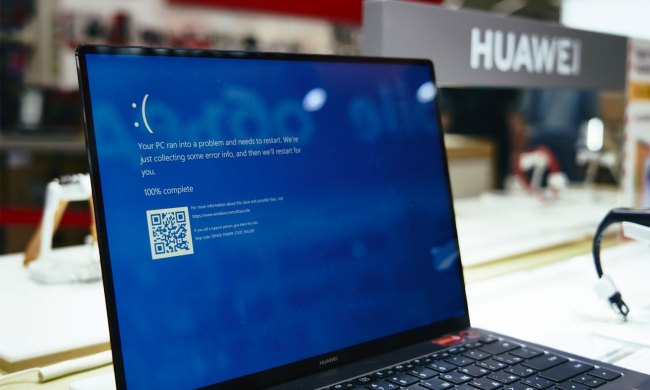I wasn’t sure what to do next. A patient’s knee was laid out on the table in front of me, and the needle in my hand was filled with anesthetic. I knew it had to be injected into one of the exposed, fleshy areas of the knee, but I wasn’t sure which part, or how much to administer. I took a clumsy jab in the direction I thought was right. It wasn’t.
Thankfully, rather than a medical catastrophe, and the sound of an incoming lawsuit to alert me of my wrongdoing, I got a big, yellow warning triangle. I was wearing Microsoft HoloLens, the “patient” wasn’t really there, and I was trying Touch Surgery’s innovative platform, which helps surgeons learn and practice an operation without the need for an actual patient.
Despite my frivolous use, it’s not a toy. There’s a chance the skilled hands that may one day operate on you, or someone you know, may have been guided ahead of time by it.
Practice makes perfect
It’s estimated there will be a need for 143 million surgical procedures in 2017 alone. Yet millions of those people do not have access to safe surgery, increasing the risks of problems arising from it. Touch Surgery wants to answer the question of how to make surgery, and the people who perform it, better. The answer isn’t that complicated. It’s access to the right knowledge, and an ability to practice ahead of time. Fulfilling that role is the hard part.
While I tried Touch Surgery on HoloLens, its main home is an app that runs on iOS and Android. You can download it and try out a procedure for yourself. In fact, the app is popular with people about to undergo an operation, helping to take the mystery out of the process. There is a huge variety of operations covered by the app, from the knee operation I performed, to emergency pericardiocentesis, and actual brain surgery. The in-app experience is more realistic in a squidgy way, while the HoloLens simulation is far less gut-wrenching; but it’s still able to make you wince.
Can a surgeon really use an app to practice surgery, and is it necessary? Surgeons don’t get to practice much. Contrary to what some may think, cadavers aren’t commonly used, and often the first surgery performed is exactly that — the very first time the doctor is doing the procedure. :
“Surgery is a process, with a series of actions, and those actions are used to navigate through the body to find the problem and fix it,” Touch Surgery CEO and founder Jean Nehme explained to Digital Trends. “The best surgeons have years of experience, telling them what to do, when, and alerting them to any potential problems. The question is, how do you take that expertise, and pass it on to new surgeons? Typically it’s done through description, transfer of knowledge through training sessions, or more recently, videos of surgeries.”
Realistic
Touch Surgery steps in here. By combining intelligence from surgical text books, studies, videos, and direct knowledge from discussions with a surgeon; it’s possible to bring it all together to create the mock procedure seen in the app. But this only comes after each surgery has been storyboarded, rendered, and animated by a team that includes members who’ve previously worked with movie effects experts Industrial Light and Magic. Realism is essential, and the team has had doctors try to move the non-existent patient’s limbs or body around while testing the platform on HoloLens, demonstrating how close to reality the experience is.
It’s estimated there will be a need for 143 million surgical procedures in 2017 alone.
Touch Surgery’s approach can be compared to the aviation industry and how it trains pilots; but unlike pilots, there’s no set amount of training hours required for a surgeon. Provided the people in charge consider them ready, surgeons are simply placed into the pressurised operating room environment with supervision.
“Anything you can do to familiarise yourself with the situation,” Nehme told us, “is enormously beneficial.” Quoting studies and research on Touch Surgery’s effectiveness, he said, “By using Touch Surgery and repeatedly testing yourself, you go from not knowing anything, to knowing what you need to know in five hours.”
Mixed reality in the future
Using augmented, or mixed, reality to do this makes sense. It’s interactive in the way an app isn’t. The needle we were fumbling with wasn’t actually there, but the process prompted us to inject in multiple locations, following a particular route, and with the right method. A qualified surgeon would of course have this knowledge, but to practice in this way could be seen as invaluable. If the training isn’t available though, perhaps in areas far removed from mainstream healthcare resources, the risks are increased. The key to being safer in the operating room, says Nehme, is to, “practice, test, test, and test again.”
Touch Surgery on HoloLens is still a work-in-progress though, and the experience was sometimes shaky. Nehme was cool on its potential. “Hololens is early in testing, and a great hardware platform, but there are limitations such as weight. It is not crucial to the app, but it would be amazing to see the technology improve, as it will create exciting opportunities for Touch Surgery.”
However, the company is working on shifting Touch Surgery procedures to other AR platforms, including its own headset that’s in development. We saw a non-working prototype, which was compact and lightweight in comparison to HoloLens. One day, once the technology improves, surgeons could wear the headset in the operating theatre, and “see” the process in real time, acting as a prompt or guide.
The cost and limited availability of Hololens and other AR headsets makes them inaccessible to many people, and in reality, it’s not what makes Touch Surgery exciting. Going back to those five million people who don’t have access to safe surgery, it’s those doctors who may end up benefiting most from the app. We were told the story of a doctor in Uganda who has found himself in the situation of needing to perform an operation completely unfamiliar to him in a matter of hours. His use of Touch Surgery ahead of time was as important to him, and his patient, as his text books and reference material.
“You can use an app to actually be better in operating rooms,” said Nehme. “Using it is the equivalent of being in a dark room and turning the lights on.”
Touch Surgery the app is free, and is currently used by surgeons at 17 leading institutions in the United States, including Harvard, NYU, Columbia, Stanford. By the end of the year, the company expects that number to reach 100. For the millions of people getting surgery in 2017, safely or otherwise, it can only be good news.





